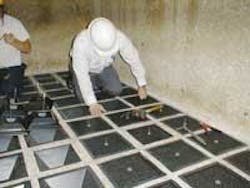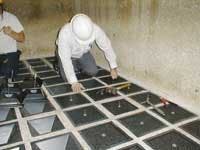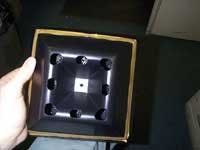Treatment Plant Stops Costly Gravity Filter Blowouts With New Protective Assemblies For Wheeler Bottoms
Water management at Logansport Municipal Utilities' (LMU) 9 mgd surface water treatment plant solved erosion-related blowouts of Wheeler bottoms in its gravity filters with PWI™ assemblies —- a new system of plastic inserts, including porous plates, manufactured and installed by Roberts Services Inc., a subsidiary of The Roberts Filter Group of Darby, PA.
Installed cost for the first four dual-cell filters was $114,000, with an additional $60,000 for an air-assisted backwash option. Similar costs are estimated for the remaining four cells. Complete demolition and rebuilding of the filtration system would have cost over $700,000. Meanwhile, failures of a previous porous plate solution, installed in 1998, were projected to cost about $25,000-50,000 per occurrence after warranty expiration.
"Our first noted occurrence of the Wheeler bottom problem in our plant, which was built in 1954, was in 1997," said Paul Hartman, LMU's water and wastewater manager. "Porcelain thimbles and concrete hopper bottoms had eroded away in at least two cells, allowing filtration media to be lost into the plenum. Several of these holes in a cell effectively blew the whole gravity filter.
"We had to remove all the gravel, sand, and anthracite remaining above, and clean out the plenums. This revealed that the concrete was badly spalled and often gone —- it could now no longer hold either the Wheeler bottom's porcelain balls, which had apparently been spinning to help cause the damage, or hold the filter media."
The Logansport plant runs at a 3 1/2 mgd annual average, with highest flow at 5 1/2 mgd. Raw water from the Eel River is first oxidized with potassium permanganate, and flocculated with liquid alum before entering clarifiers. It then enters the filtration system of four dual-cell gravity filters. Chlorine gas is applied at the raw water intake and at the entrance and exit of the filtration system. Fluoride is added at the point of entry to the distribution system.
The filters had been originally designed with standard Wheeler bottoms — concrete pyramidal hoppers, porcelain balls, and porcelain thimbles (exit orifices). Filter media originally consisted typically of four 3 inch layers of gravel; one layer of sand, 1 - 1 1/2 feet; and one layer of anthracite, also 1 - 1 1/2 feet.
Hartman reported his first option selected to solve the problem was to install a porous plate across the top of his Wheeler bottoms, using a combination of sealant and bolts. That solution did not prove satisfactory and had to be repaired a number of times.
Hartman said he entertained the notion of ripping out the Wheeler bottoms and installing brand new underdrain systems, but then discovered that Roberts Services offered a Wheeler bottom rehabilitation service.
"They re-formed the concrete hoppers, fixed chips and holes, replaced porcelain thimbles, and furnished and installed new filter media," he said. "Then they placed their PWI's in each re-formed hopper, with their own porous plates inside the inserts and flush with the surface. The assembly was easily held in place with a stainless steel rod running from the top of the porous plate, down through the porcelain thimble, with a stainless steel toggle bolt at the bottom."
"We felt if it didn't work, we could have gone back to the porcelain balls, but the plastic inserts prevented further degradation of the concrete hoppers, so we didn't have to."
Hartman said he was able to change to a three inch layer of pea gravel in place of the original four layers of gravel; restored sand and anthracite in approximately original depth; and changed to Roberts' air-assisted backwash system to help break up suspended particles.
"It's a system of stainless steel air diffusers and laterals that lay right on the bottom of the filter, with air bubbling up from there," he said. "By using air as a backwash aid, we've been able to achieve a much more effective backwashing."
"We've had the new assemblies installed in the first four cells since last October, and have not yet had to go back in for any repairs," he said. "We'll need one full winter to know for sure that we've finally solved the problem, but are very encouraged that we're already more than halfway there."
According to Roberts Services, the new product is designed to account for proper hydraulic balance of Wheeler bottoms. The company says it has been building and rehabilitating monolithic Wheeler bottoms for over 60 years.
Their rehab process typically consists of repairing chips and restoring shape and spalled-out surfaces for concrete hoppers, as well as replacing thimbles as needed, resulting in a like-new condition. The rigid polystyrene PWI's are vacuum-formed. The polyethylene porous plates are rested on a formed shelf inside these inserts, and anchored to the underdrains in drywall fashion via stainless steel rods and toggle bolts.
Thus, the porous plate is mounted on the consistent-surface insert rather than directly to the inconsistent-surface concrete, in order to provide a smooth and consistent seal, and thereby effectively perform the distribution function that is otherwise typically provided by porcelain balls.


